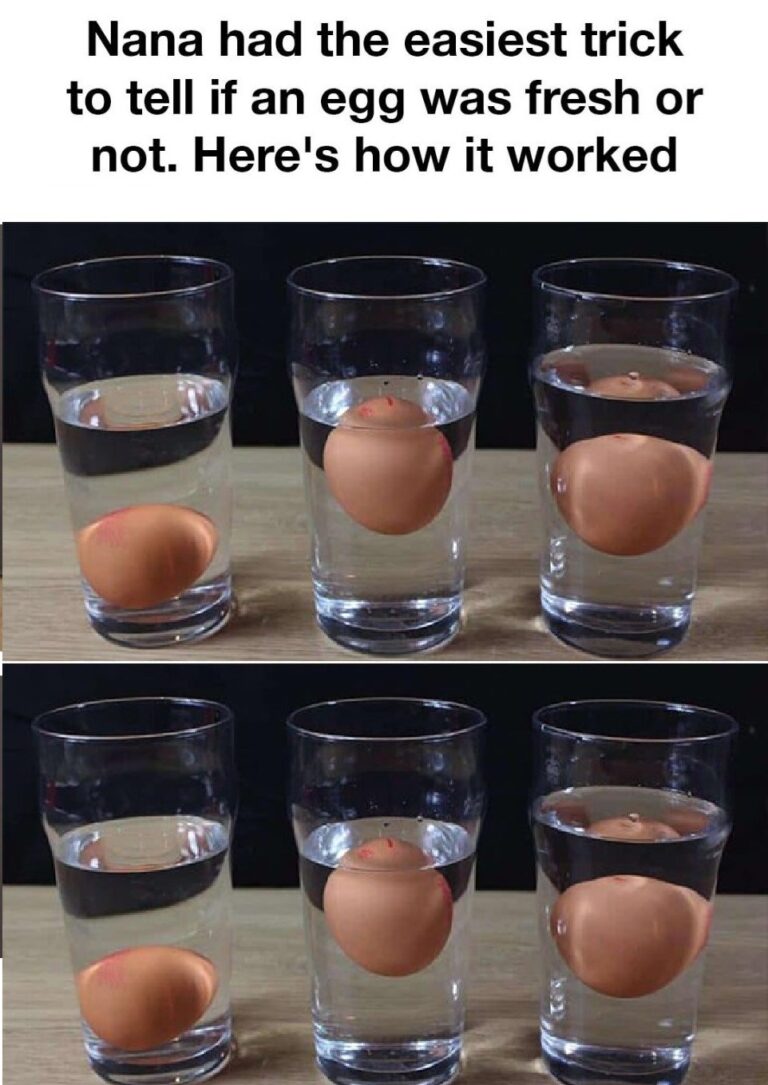ADVERTISEMENT
Didn’t Know About This Technique Until Now

Step-by-Step Guide to Nana’s Egg Freshness Test
Here’s how you can easily perform Nana’s egg freshness test at home:
- Fill a Bowl with Water
Fill a bowl or glass with cold water, deep enough to fully submerge the egg. - Gently Place the Egg in the Water
Place the egg carefully in the water and observe how it behaves. - Check the Results:
- Sinks and Lays Flat: If the egg sinks to the bottom and lays flat, it is very fresh.
- Sinks but Stands Upright: If it sinks but stands on one end, it’s still good to eat but not as fresh. Use it soon.
- Floats to the Top: If the egg floats, it is no longer fresh and should be discarded.
This quick and simple test gives you a reliable indication of an egg’s freshness in seconds.
Why Nana’s Method Works
Nana’s method works because of changes in the egg’s air cell as it ages. Over time, moisture evaporates from the egg through its porous shell, causing the air cell to expand. This larger air pocket makes the egg more buoyant, which is why older eggs tend to float. Fresh eggs, with a smaller air pocket, are denser and remain on the bottom. This principle of buoyancy is the science behind the simplicity of Nana’s test.
Comparing Other Egg Freshness Testing Methods
Although Nana’s water test is widely used, there are other methods to check an egg’s freshness:
- Candling: Shining a light through the egg to inspect its internal structures, often used in the egg industry.
- Crack Test: Cracking the egg open to examine the yolk and whites; fresh eggs have firm yolks and thick whites.
- Shake Test: Shaking the egg near your ear; if you hear sloshing, the egg is likely old.
While these methods can be effective, some require experience or special equipment. Nana’s water test remains accessible and easy for everyone.
Scientific Explanation Behind the Trick
The egg’s porous shell allows air to enter and moisture to leave over time. As the air cell grows larger, the egg becomes more buoyant, floating when it’s no longer fresh. Simultaneously, the proteins inside the egg degrade, affecting its consistency and quality. By using water to detect these changes, Nana’s trick makes basic principles of chemistry and physics accessible to the home cook.
Common Misconceptions About Egg Freshness
There are several myths about egg freshness:
- Cracked eggs should always be discarded: While floating cracked eggs should be thrown away, minor cracks can be safe to use if the egg passes the float test.
- Cloudy whites mean spoilage: Cloudy egg whites are actually a sign of freshness, as carbon dioxide hasn’t yet escaped.
- All eggs with spots are bad: Blood or meat spots are harmless and can occur even in very fresh eggs.
Distinguishing these myths from facts ensures you handle your eggs correctly.
Frequently Asked Questions About Egg Freshness
Here are some common questions about egg freshness:
- How long do eggs stay fresh? Properly stored eggs can stay fresh for 3-5 weeks.
- Can I use eggs past their expiration date? If they pass the float test, they are likely still safe but should be used soon.
- Should eggs be refrigerated? Yes, refrigeration extends their freshness.
- What if an egg floats? Discard it, as it’s no longer fresh.
Conclusion: Trusting Nana’s Time-Tested Trick
Nana’s egg freshness test has stood the test of time because it’s simple, effective, and requires nothing more than water. As food safety becomes an increasing priority, this traditional method provides peace of mind in ensuring the eggs you use are fresh. By incorporating Nana’s trick into your kitchen routine, you’ll elevate both the quality and safety of your cooking. Trust in this time-honored technique and enjoy your eggs with confidence.
ADVERTISEMENT